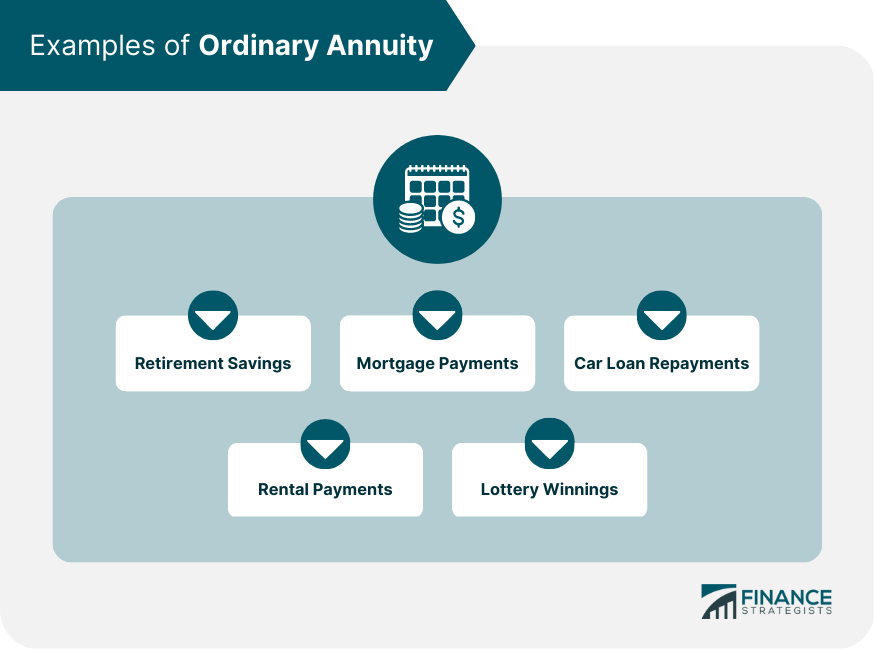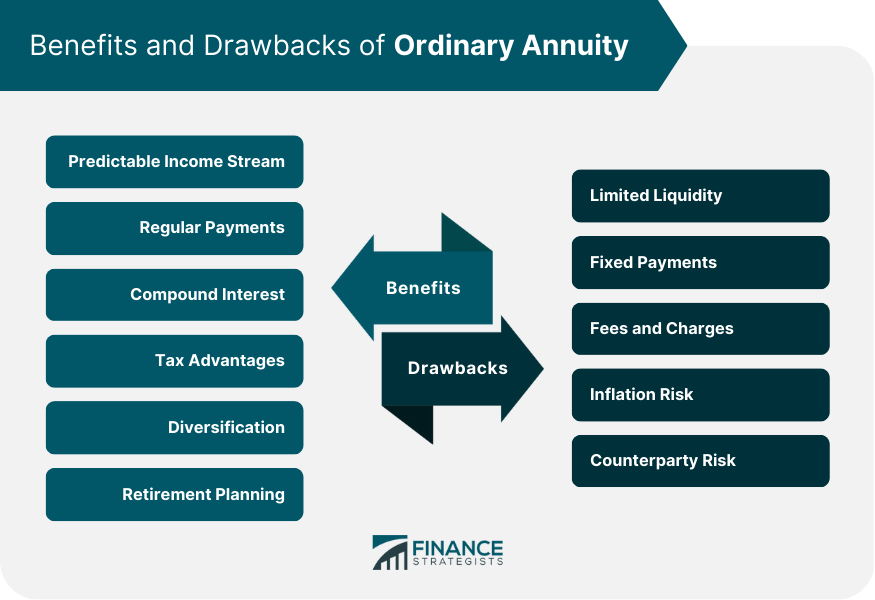An ordinary annuity is a financial product that provides a series of cash flows over a set period of time, with the payments typically made at the end of each period. An ordinary annuity can be a useful tool for budgeting, meeting financial obligations, and planning for retirement. In an ordinary annuity, the payments are made at the end of each period, such as every month or every year, for a fixed number of periods. The amount of the payments, the interest rate, and the number of periods are all predetermined and agreed upon when the annuity is purchased. The payments from an ordinary annuity can be fixed or variable, depending on the type of annuity. A fixed annuity provides a fixed payment or interest rate, while a variable annuity provides a payment based on underlying investments' performance. Overall, an ordinary annuity can provide a predictable and consistent income stream over a set period, which can be useful for budgeting, planning, and achieving financial goals. To illustrate, suppose you want to save for retirement by investing in an annuity. You decide to invest a certain amount of money every month for the next 20 years. The annuity provider agrees to pay you a fixed rate of return on your investment for the duration of the annuity and to pay you a fixed amount every month for 20 years. Assuming you invest $500 per month and the annuity provider offers a fixed rate of return of 5%, your annuity would work as follows: At the end of the first month, you would invest $500, and the provider would pay you 5% interest on that amount, which is $25. Your balance at the end of the first month would be $525. At the end of the second month, you would invest another $500, and the provider would pay you 5% interest on your total balance of $525, which is $26.25. Your balance at the end of the second month would be $1,051.25. This process would continue for 20 years, with you making monthly investments and the provider paying you interest on your balance at the end of each month. At the end of the 20-year period, the annuity would mature, and the provider would stop making payments. By this point, you would have received a total of 240 payments, and your final balance would be the sum of all of these payments plus the interest earned on your investment over the 20-year period. Consider the following instances: A person may choose to invest a fixed amount of money every month for a certain number of years to accumulate savings for their retirement. The annuity provider agrees to pay a fixed rate of return on the investment and to pay a fixed amount every month for the duration of the annuity. A homeowner borrows money from a lender to buy a property and makes regular payments towards the loan over a set number of years. Each payment includes both principal and interest, with the interest portion gradually decreasing over time as the loan is paid off. A person may borrow money to buy a car and repay the loan in equal installments every month for several years. Each payment includes both principal and interest, with the interest portion decreasing over time as the loan is paid off. A tenant may pay a fixed amount of rent to their landlord every month for the duration of their lease agreement. Each payment is a set amount and is made at the end of each period. Instead of receiving their prize in one lump sum, a lottery winner may receive it as a series of fixed payments over a predetermined number of years, each payment made at the end of each period. There are several benefits of an ordinary annuity, including: An ordinary annuity offers a steady and predictable source of income for a specified duration, which can be advantageous for purposes of financial planning and budgeting. The payments from an ordinary annuity are typically made at the end of each period, such as every month or every year, which makes it easier to plan for ongoing expenses and to meet financial obligations. An ordinary annuity has the potential to generate compound interest, where the interest earned on the investment is reinvested to produce more interest. As time passes, this can greatly enhance the overall earnings. An ordinary annuity may offer tax advantages, such as tax-deferred growth on the investment, which means that taxes are not paid until the money is withdrawn from the annuity. An ordinary annuity can be used as part of a diversified investment portfolio, which can help to spread risk and reduce the overall level of risk in the portfolio. An ordinary annuity can be a useful tool for retirement planning, as it can provide a regular income stream during retirement. While there are several benefits to an ordinary annuity, there are also some potential disadvantages to consider. These include: An ordinary annuity is typically a long-term investment, and it can be difficult or expensive to access the funds before the end of the term. It can limit liquidity and flexibility in managing financial needs. The payments from an ordinary annuity are fixed and cannot be adjusted based on changes in financial needs or circumstances. An ordinary annuity may come with fees and charges, such as administrative fees, surrender charges, and mortality and expense charges. These fees can reduce the overall return on the investment. The fixed payments from an ordinary annuity may not keep up with inflation, which means that the payments' purchasing power may decrease over time. An ordinary annuity may be subject to interest rate risk, which means that if interest rates rise, the fixed payments from the annuity may be less valuable in real terms. An ordinary annuity is an agreement between the investor and the annuity provider. If the provider becomes insolvent or fails to meet its obligations, the investor may lose some or all of their investment. An ordinary annuity is a financial product that can provide a predictable and consistent income stream over a set period. It can be a useful tool for budgeting, meeting financial obligations, and planning for retirement. The payments from an ordinary annuity can be fixed or variable, and it has the potential to generate compound interest and offer tax advantages. However, there are also some potential drawbacks to consider, such as limited liquidity, fixed payments, fees and charges, inflation risk, interest rate risk, and counterparty risk. Despite these potential disadvantages, an ordinary annuity can be a valuable addition to a diversified investment portfolio and help provide financial security and stability over the long term. Consult a qualified financial advisor, insurance broker, or wealth management professional for further guidance on ordinary annuity and how it can be used to achieve your financial goals while considering your situation and risk tolerance.What Is an Ordinary Annuity?
How Ordinary Annuity Works
Examples of Ordinary Annuity
Retirement Savings
Mortgage Payments
Car Loan Repayments
Rental Payments
Lottery Winnings

Benefits of Ordinary Annuity
Predictable Income Stream
Regular Payments
Compound Interest
Tax Advantages
Diversification
Retirement Planning
Drawbacks of Ordinary Annuity
Limited Liquidity
Fixed Payments
Fees and Charges
Inflation Risk
Interest Rate Risk
Counterparty Risk

Final Thoughts
Ordinary Annuity FAQs
An ordinary annuity is a financial product that provides a series of cash flows over a set period of time, with payments typically made at the end of each period. The payments, interest rate, and number of periods are predetermined and agreed upon when the annuity is purchased. The payments can be fixed or variable, depending on the type of annuity.
The benefits of an ordinary annuity include a predictable income stream, regular payments, compound interest potential, tax advantages, diversification, and usefulness for retirement planning.
The drawbacks of an ordinary annuity include limited liquidity, fixed payments, fees and charges, inflation risk, interest rate risk, and counterparty risk.
Yes, an ordinary annuity can be a useful tool for retirement planning, as it can provide a regular income stream during retirement.
Examples of ordinary annuity include retirement savings, mortgage payments, car loan repayments, rental payments, and lottery winnings received as a series of fixed payments over a predetermined number of years.
True Tamplin is a published author, public speaker, CEO of UpDigital, and founder of Finance Strategists.
True is a Certified Educator in Personal Finance (CEPF®), author of The Handy Financial Ratios Guide, a member of the Society for Advancing Business Editing and Writing, contributes to his financial education site, Finance Strategists, and has spoken to various financial communities such as the CFA Institute, as well as university students like his Alma mater, Biola University, where he received a bachelor of science in business and data analytics.
To learn more about True, visit his personal website or view his author profiles on Amazon, Nasdaq and Forbes.











